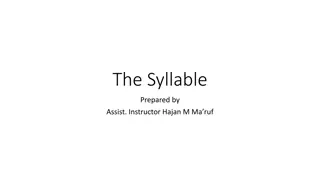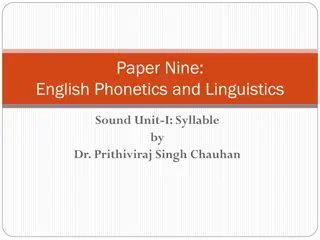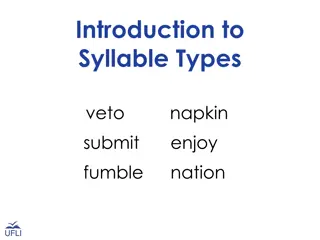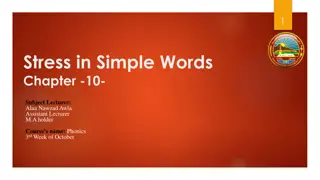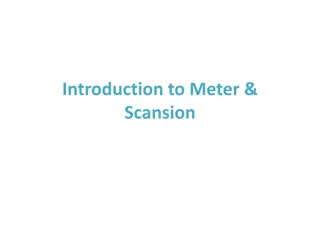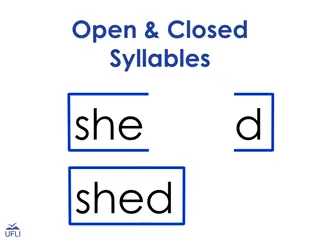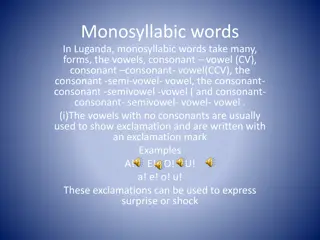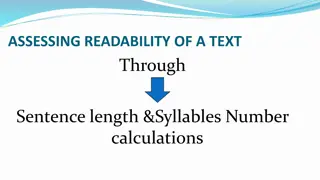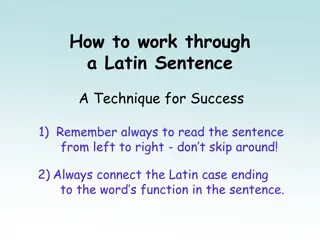Latin Syllables and Vowel Length Rules
Learn about the division of Latin words into syllables based on vowels, the rules for accent positions, distinguishing long and short vowels through special marks, and recognizing syllables that are always long or short. Explore how Latin vowels are categorized by nature and marked in dictionaries to help with pronunciation.
Download Presentation

Please find below an Image/Link to download the presentation.
The content on the website is provided AS IS for your information and personal use only. It may not be sold, licensed, or shared on other websites without obtaining consent from the author.If you encounter any issues during the download, it is possible that the publisher has removed the file from their server.
You are allowed to download the files provided on this website for personal or commercial use, subject to the condition that they are used lawfully. All files are the property of their respective owners.
The content on the website is provided AS IS for your information and personal use only. It may not be sold, licensed, or shared on other websites without obtaining consent from the author.
E N D
Presentation Transcript
DIVISION OF WORDS INTO SYLLABLES Every Latin word has as many syllables as it has vowels or diphthongs. In Latin syllables are usually counted from the end of a word (from the right to the left). E.g.: Ar- te- ri- a (artery) 4 3 2 1 Ar- ti- cu- la- ti- o (joint) 6 5 4 3 2 1
THE MAIN RULES FOR THE POSITION OF AN ACCENT IN LATIN The final syllable of a word is not stressed. In disyllabic words the second syllable from the end of the word is always stressed. In polysyllabic words the second or the third syllable from the end of the word is stressed (the place of stress depends on the length or brevity of the second syllable).
Length and brevity of the vowels Long ( , , , , ) Short ( , , , , ) depends on its position depends on its nature depends on its position depends on its nature Diphthongs are always long by their nature: gangraena mortification, gangrene pharmaceuta - pharmacist
Length and brevity by nature In dictionaries and textbooks both long and short by their nature vowels are graphically signed with the special marks. The long vowels are usually marked out by a line over the top of the vowel called a macron ( ) (or stroke): pyl rus pyl rus The short vowels are indicated in dictionaries and textbooks by a circumflex ( ) on the vowel: skel ton sk leton
The following syllables are always long: - ra: - tis: - sis: - ma: - l-: - r-: - n-: - n-: - t-: - s-: - t-: natura (nature) nephr tis(inflammation of the kidney) dermat sis (a disease of the skin) oste ma lateralis (lateral) ulnaris (ulnar) pelvinus (pelvic) medianus (median) destillatus (destilled), ceratus (waxy) muc sus (mucous), fibrosus (fibrous) dilutus (diluted)
The following syllables are always short: - c-: - d-: - l-: - l-: - l-: chronicus (chronic), gastricus (gastric) calidus (hot) particula (part), musculus (muscle) foveola (pit) mobilis (mobile)
Length by position The syllable is long, if a vowel of this syllable is followed by two or more consonants: malignus (malignant) maxilla (the upper jaw) a vowel of this syllable is followed by letters x, z: reflexus (reflex) Oryza (rice) Nota bene!!! The vowel is not lengthened by consonants b, p, d, t, g, c in combination with r, l: cerebrum (brain) palpebra (eyelid)
Brevity by position The syllable is short, if its vowel is followed by another vowel: brachium (arm) linea (line) its vowel is followed by digraphs ch, ph, th, rh: choledochus (bile duct) a vowel of this syllable is followed by letter h: contraho (collect)
So, to stress correctly a Latin word you should: divide a word into its syllables, find the next to last syllable, determine whether the next to last syllable is long or shot. If the next to last syllable is shot, the accent is shifted to the third syllable from the end of the word. Nota bene!!! If the word can t be read according to any stress rule you should consult a dictionary.
ACCENT IN WORDS OF GREEK ORIGIN Borrowings of Greek origin are stressed according to the rules of the Greek language: In Greek clinical terms with the ending -ia the letter i is always stressed: myopath a myopathia dysenter a dysentery hypoton a hypotension Except for the words containing Greek root -logia: biol gia biology pharmacol gia pharmacology
EXERCISES Determine the length and brevity of the second syllable: atrium atrium; colon - colon; cerebrum cerebrum; choledochus bile; diaphragma diaphragm; felleus bile; femur femur; ganglion ganglion; ileum ileum; ligamentum ligament; manubrium manubrium; papilla papilla; palpebra eyelid; vertebra vertebra; cornea cornea; brachium arm; cerebellum cerebellum; columna column; fovea facet; gluteus gluteus; labium lip; mentum chin; sanguis blood.
EXERCISES Determine the length and brevity of suffixes in the words: flexura flexure; calidus hot; medianus median; auditivus auditory; apicalis apical; cervicalis cervical; corticalis cortical; dentatus gear; fibrosus fibrous; gastricus gastric; maxillaris maxillar; frigidus cold; retina retina; zygomaticus zygomatic; caudatus cudat; mobilis mobile; particula part; acusticus auditory; cardiacus cardiac; commissura comissure; fluidus liquid; anularis ring; frenulum frenulum; lingula tongue; mucosus mucous; opticus optic; tuberculum tubercle.
EXERCISES Determine the length and brevity of the second syllable, put the stress: aequus equal; biceps biceps; costalis costal; ethmoidalis ethmoidal; hepaticus hepatic; mandibula mandible; opponens opponens; paries wall; radius radius; retinaculum retinaculum; tibia tibia; a r air; cilium eyelash; ductulus duct; facies face; laryngeus laryngeal; musculus muscle; ostium orifice; pleura pleura; recessus recess; sutura suture; vestibulum vestibule.
EXERCISES Determine the length and brevity of the second syllable, put the stress: apex dentis apex of tooth; costa lumbalis lumbar rib; margo posterior posterior border; processus styloideus ulnae ulnar styloid process; phalanx media middle phalanx; linea arcuata arcuate line; sulcus obturatorius obturator groove; distantia intercristalis intercristal distance; inclinatio pelvis pelvic inclination; tuberculum quadratum quadrate tubercle; juncturae cartilagineae cranii cranial cartilaginous joints.
EXERCISES Determine the length and brevity of the second syllable, put the stress: angulus mandibulae angle of mandible; arcus zygomaticus arch zygomatic; curvatura primaria curvature primary; collum mandibulae neck of mandible; basis cranii base cranial; corpus ossis hyoidei body of hyoid bone; fovea dentis dental fovea; incisura vertebralis superior superior vertebral notch; pediculus arcus vertebrae pedicle; facies articularis inferior inferior articular facet.
EXERCISES Stress the words: scapula (shoulder-blade), mandibula (lower jaw), clavicula (clavicle), fibula (fibula), maxillaris (maxillary), chronicus (chronic), gastricus (gastric), pelvinus (pelvic), fibrosus (fibrous), gelatinosus (gelatinous), venosus (venous), squamosus (scaly), spirituosus (spiritual), capitatus (capitate), destillatus (destilled), ceratus (waxy), auditivus (auditory), vegetativus (vegetative), incubativus (incubative),incisivus (incisive, cutting), junctura (junction), temperatura (temperature).
EXERCISES Stress the words: apertura (opening), angulus (angle), incisura (notch, split), spinosus (spinous), articularis (articular), basilaris (basic), musculus (muscle), lateralis (lateral), lumbalis (lumbar), ventriculus (ventricle), anulus (ring), foveola (pit), tuberculum (tubercle), thoracicus (thoracic), opticus (visual), cervicalis (cervical), fissura (cleft), vertebralis (vertebral), fossula (small depression), glandula (gland),
EXERCISES Practise stressing the following Latin anatomical terms: articulatio atlantooccipitalis (joint between first cervical vertebra and occipital bone), canalis vertebralis (vertebral canal), sulcus costovertebralis minor (major) (small (large) costovertebral furrow), incisurae costales (costal slits), ligamentum cap tis costae (ligament of the head of rib), articulatio cap tis costae (joint of the head of rib), spatia intercostalia (intercostal spaces), apertura thor cis superior (inferior) (superior (inferior) thoracic apertura), angulus infrasternalis (angle, situated below or beneath sternum), fissura sterni (narrow slit of breast bone).
EXERCISES Practise stressing the following Latin anatomical terms: costa fluctuans (free rib), vertebra thoracica (thoracic vertebra), columna vertebralis (spinal column), processus articularis superior (higher joint appendix), tuberculum anterius (anterior tubercle), facies articularis anterior(anterior joint surface), sulcus arteriae vertebralis (vertebral furrow of artery), nucleus pulposus (pulpal nucleus), anulus fibrosus (fibrous ring of tissue about an opening), ligamentum longitutinale anterius (anterior longitudunal ligament).
Sample of QUIZ #1 1. Choose the word in which the letter c is pronounced as /ts/: a) capitulum; b) corpus; c) cauda; d) caecus; e) cubitus. 2. Choose the word in which the letter s is pronounced as /s/: a) rosa; b) platysma c) vasa; d) costa; e) incisura. 3. Choose the word in which the letter ngu is pronounced as /ngu/: a) inguinalis; b) unguis; c) unguentum; d) angustus; e) sanguis. 4. Choose the word in which the letter ti is pronounced as /ti/: a) bestia; b) articulatio; c) sanatio; d) injectio; e) substantia. 5. The letter x in the word exemplum is pronounced as: a) /s/; b) /ks/; c) /k/; d) /kz/; e) /z/. 6. Choose the word in which the diphthong oe is pronounced separately: a) coena; c) oesophagus; e) oedema. 7. Choose the word, which contains dygraph, that is pronounced as /kh/: a) phalanx; b) asthma; c) concha; d) thorax; e) rhaphe. 8. Which word keeps the accent in the antepenultimate syllable? a) gangraena; b) apertura; c) capitulum; d) reflexus; e) patella. 9. Write the transcription for the following words, put the accent: mobilis, acusticus, commissura, corticalis, maxillaris, mucosus, zygomaticus. b) lagoena; d) haemopo sis;




